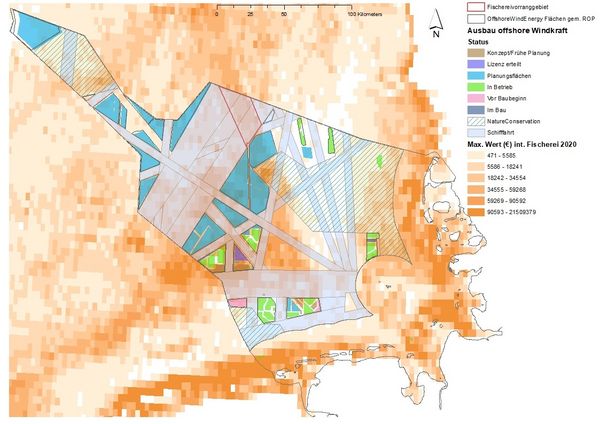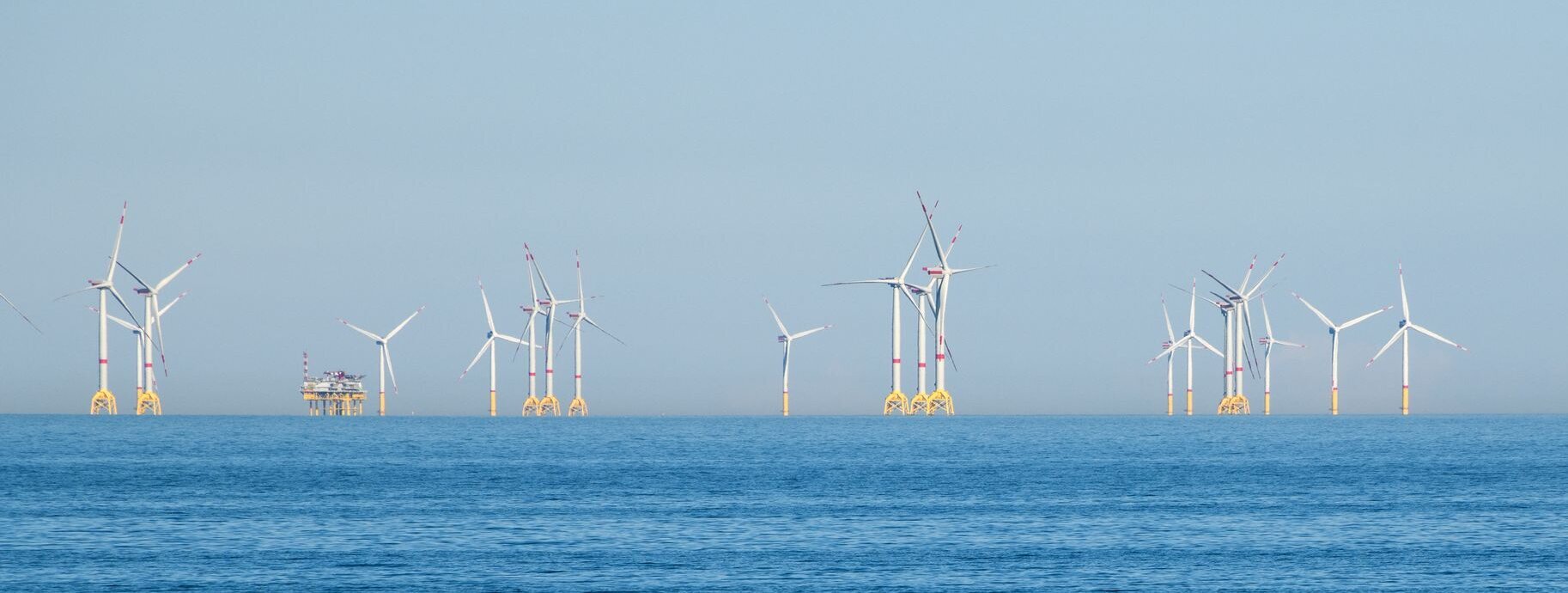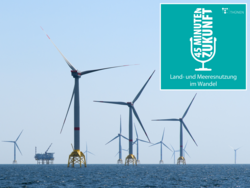Dossier
Marine Space Utilization
Vanessa Stelzenmüller | 27.06.2022
Offshore renewable energy is an important building block for achieving climate goals. But it leads to severe space constraints for other uses, such as fishing, as these uses have so far been considered incompatible.
It's getting crowded on the seas ...
The massive expansion of offshore wind energy will lead to an unprecedented change in the use of marine space in the North and Baltic Seas in the future. German maritime spatial planning alone designates almost 20% of the area of the Exclusive Economic Zone (EEZ) of the North Sea for wind energy use in the future - and this does not even take into account the more ambitious expansion targets envisaged in the coalition agreement of the current German government. Currently, wind turbines are installed on approximately 2.6% of the area of the German EEZ. A further 28% of the area is designated as marine protected areas, in which, however, other uses have mostly not yet been regulated. The fishery priority area for Norway lobster (Nephrops norvegicus), also known as Norwegian lobster, which was introduced in 2021, occupies about 2.15 % of the area (see figure).

... but there are solutions ...
However, the foreseeable area loss for fishing activities can be countered with innovative and integrative spatial use concepts. For example, co-use of offshore wind farms and fishing with passive and selective fishing gear in ecologically suitable regions could be a fitting concept. We have shown how energy generation, fisheries and nature conservation can be thought together on the high seas in an illustrative Thünen à la carte "Offshore wind farms: opportunity for fisheries and nature conservation".
For example, the edible crab (Cancer pagurus), a little-used but attractive fishery resource, is increasingly settling on and around the stony scour protection of the foundations. We were able to show this in a pilot study, and you can get a glimpse of our work at sea as part of this project here. Preliminary calculations have shown that crab fishing near the turbines can be a profitable alternative during the summer months. However, more extensive information on the population dynamics of edible crabs and the actual feasibility of such a fishery in the immediate vicinity of the turbines is needed for robust predictions of profitability. The final implementation of such concepts in the future requires a trustful and transparent cooperation of wind power industry, fishery, spatial planning authority, nature conservation and science.
... and still much to explore
The redistribution and reallocation of marine spatial uses have economic and socio-cultural consequences for fisheries through the loss of fishing areas. It also affects the marine ecosystem and its functions. Thus, in addition to the edible crab as a new fisheries resource, we are also exploring the direct effects of wind turbines on the aggregation of fishes such as cod. Not yet published results show an increased occurrence of fish at scour protections with rocks. In the future, our main goal is to gain a better understanding of these relationships and the associated ecological changes.
Overall, our results to date indicate that the evaluation of future spatial use concepts requires a comprehensive, holistic (ecological and economic) as well as a small-scale approach. Thus, the development of holistic assessments of the costs, benefits, and risks of future spatial use concepts are also central to our work. This includes, among other things, assessing the cumulative pressures of human activities and climate change on the near-bottom fish and benthic community.
Publications
- 0
Stelzenmüller V, Letschert J, Gimpel A, Kraan C, Probst WN, Degraer S, Döring R (2022) From plate to plug: The impact of offshore renewables on European fisheries and the role of marine spatial planning. Renewable Sustainable Energy Rev 158:112108, DOI:10.1016/j.rser.2022.112108
- 1
Gissi E, Manea E, Mazaris AD, Fraschetti S, Almpanidou V, Bevilacqua S, Coll M, Guarnieri G, Lloret-Lloret E, Pascual M, Petza D, Rilov G, Schonwald M, Stelzenmüller V, Katsanevakis S (2021) A review of the combined effects of climate change and other local human stressors on the marine environment. Sci Total Environ 755(Part 1):142564, DOI:10.1016/j.scitotenv.2020.142564
- 2
Stelzenmüller V, Cormier R, Gee K, Shucksmith R, Gubbins M, Yates KL, Morf A, Nic Aonghusa C, Mikkelsen E, Tweddle JF, Peccu E, Kannen A, Clarke SA (2021) Evaluation of marine spatial planning requires fit for purpose monitoring strategies. J Environ Manag 278(Part 2):111545, DOI:10.1016/j.jenvman.2020.111545
- 3
Schupp MF, Kafas A, Buck BH, Krause G, Onyango V, Stelzenmüller V, Davies IM, Scott BE (2021) Fishing within offshore wind farms in the North Sea: Stakeholder perspectives for multi-use from Scotland and Germany. J Environ Manag 279:111762, DOI:10.1016/j.jenvman.2020.111762
- 4
Probst WN, Stelzenmüller V, Rambo H, Moriarty M, Greenstreet SPR (2021) Identifying core areas for mobile species in space and time: A case study of the demersal fish community in the North Sea. Biol Conserv 254:108946, DOI:10.1016/j.biocon.2020.108946
- 5
Stelzenmüller V, Gimpel A, Haslob H, Letschert J, Berkenhagen J, Brüning S (2021) Sustainable co-location solutions for offshore wind farms and fisheries need to account for socio-ecological trade-offs. Sci Total Environ 776:145918, DOI:10.1016/j.scitotenv.2021.145918
- 6
Letschert J, Stollberg N, Rambo H, Kempf A, Berkenhagen J, Stelzenmüller V (2021) The uncertain future of the Norway lobster fisheries in the North Sea calls for new management strategies. ICES J Mar Sci 78(10):3639-3649, DOI:10.1093/icesjms/fsab204
- 7
Stelzenmüller V, Coll M, Cormier R, Mazaris AD, Pascual M, Loiseau C, Claudet J, Katsanevakis S, Gissi E, Evagelopoulos A, Rumes B, Degraer S, Ojaveer H, Moller T, Giménez J, Piroddi C, Markantonatou V, Dimitriadis C (2020) Operationalizing risk-based cumulative effect assessments in the marine environment. Sci Total Environ 724:138118, DOI:10.1016/j.scitotenv.2020.138118
- 8
Katsanevakis S, Coll M, Fraschetti S, Giakoumi S, Goldsborough D, Macic V, Mackelworth P, Rilov G, Stelzenmüller V, Albano PG, Bates AE, Bevilacqua S, Gissi E, Hermoso V, Mazaris AD, Pita C, Rossi V, Teff-Seker Y, Yates KL (2020) Twelve recommendations for advancing marine conservation in European and contiguous seas. Front Mar Sci 7:565968, DOI:10.3389/fmars.2020.565968
- 9
Degraer S, van Lancker V, Dijk TAGP van, Birchenough SNR, Witte B de, Elliott M, le Bot S, Reiss H, Stelzenmüller V, van Gaever S, Balian E, Cox D, Hernandez F, Lacroix G, Lindeboom H, Reubens J, Soetaert K (2019) Interdisciplinary science to support North Sea marine management: lessons learned and future demands. Hydrobiologia 845(1):1-11, DOI:10.1007/s10750-019-04109-9
- 10
Stelzenmüller V, Coll M, Mazaris AD, Giakoumi S, Katsanevakis S, Portman ME, Degen R, Mackelworth P, Gimpel A, Albano PG, Almpanidou V, Claudet J, Essl F, Evagelopoulos T, Heymans JJ, Genov T, Kark S, Micheli F, Pennino MG, Rilov G, et al (2018) A risk-based approach to cumulative effect assessments for marine management. Sci Total Environ 612:1132-1140
- 11
Cormier R, Stelzenmüller V, Creed IF, Igras J, Rambo H, Callies U, Johnson LB (2018) The science-policy interface of risk-based freshwater and marine management systems: From concepts to practical tools. J Environ Manag 226:340-346, DOI:10.1016/j.jenvman.2018.08.053


![[Translate to English:] Offshore wind farm as a cod refuge](/media/_processed_/6/8/csm_Foto_Skizze_und_Dorsche_in_Luebecker_Bucht_Thuenen-InstitutC.Bukowski_Mareike_Zech_5b6850ad3f.png)

![[Translate to English:] Logo des Bundesministerium für Ernährung und Landwirtschaft](/media/allgemein/logos/BMEL_Logo.svg)